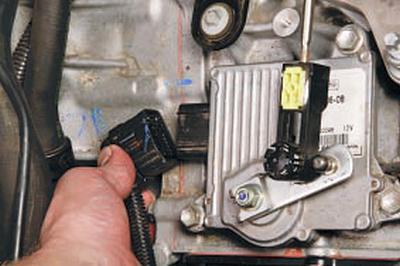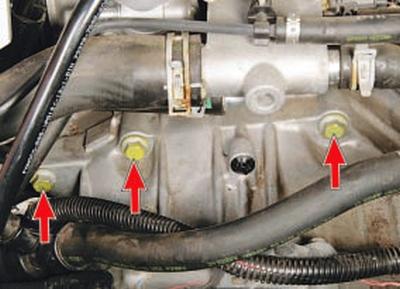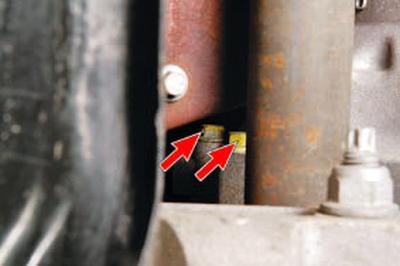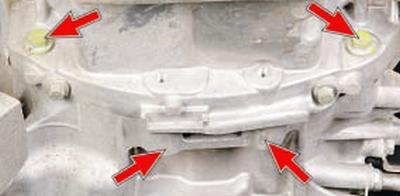In addition, the gearbox is removed to replace the clutch, flywheel and rear engine crankshaft oil seal.
An automatic transmission is removed for almost the same reasons as a manual transmission, except for the need to replace the clutch and flywheel, which in this case are absent.
Removal and installation techniques for manual and automatic transmissions are almost the same and are described using the example of a manual transmission. The difference lies in the size and number of transmission control cables, as well as the presence of hydraulic hoses in the automatic transmission connecting the gearbox to the cooling radiator.
USEFUL ADVICE: The work of removing and installing the gearbox is very laborious, so be sure to first make sure that its malfunctions are not caused by other reasons (insufficient oil level, defects in the clutch drive, loosening of the gearbox, etc.).
GOOD ADVICE: The gearbox is quite heavy and its shape is awkward to hold, so we recommend removing it with an assistant.
To remove the manual transmission, follow these steps.
NOTE: Removal and installation of a manual transmission is shown on the example of the removal of a transmission mod. iB5.
You will need: wrenches "for 8", "for 10", "for 13", "for 15", a socket head "for 13" with a ratchet, a screwdriver with a flat blade.
1. Place the vehicle on a lift or pit.
2. Remove the air filter (refer to Removing and installing the air filter and intake silencer).
3. Remove the mudguard and crankcase protection (see Removal and installation of mudguard and crankcase protection).

4. Drain the oil (working fluid) from the gearbox (see Manual Transmission Oil Change or Automatic Transmission Fluid Change).

5. Remove the front wheel drives (see Removing and installing front wheel drives).

6. Disconnect the transmission control cables from the gearbox (refer to Transmission Control Cable Replacement).

7. Remove the battery tray (refer to Removing and Installing the Battery Shelf).

8. Disconnect the wiring harness connector from the reversing light switch (refer to Checking and Replacing the Reversing Light Switch) …

9….pry with a screwdriver…

10.... Disconnect the reverse light switch harness holder from the gearbox housing and move the harness to the side.

11. Disconnect the wiring harness connector from the speed sensor (refer to Checking and Replacing Engine Control Sensors).
12. Prying with a screwdriver, remove the spring retainer of the clutch release hydraulic hose tip..

13.... and disconnect the hose from the hydraulic tube.
NOTE: Take precautions against oil leakage from the hydraulic clutch release tube (for example, plugging the tube opening with a rag or wooden plug).

14. Turn out a bolt of fastening of arms of hoses to a case of a transmission …

15.... and move the bracket along with the hoses to the side.

16. Turn out a bolt of fastening of "mass" wires to an arm of a body …

17.... disconnect the wires from the bracket and take them to the side.

18. Remove the mounting bolts and remove the starter from the clutch housing without disconnecting the wires from it (see Removing and installing the starter). Take the starter aside and secure in any way so that it does not interfere with further work.
19. Securely support the engine or hang it out using a hoist. Install a similar support under the gearbox.
20. Remove the left powertrain mount (refer to Left Powertrain Mount Replacement).

21. Remove one bolt securing the gearbox housing to the engine from the top left..

22….and to the right…

23….two bolts on the left side…

24.... and five bolts from the bottom.

25. Remove the rear suspension support of the power unit (refer to Powertrain Rear Mount Replacement).

26. Move the gearbox back until the input shaft of the box comes out of the hub of the clutch disc.

27. Move the box as far back as possible, remove the support from under it and, tilting the back of the box down, remove it from the car.
WARNING: When removing the gearbox, do not rest the end of the input shaft on the petals of the diaphragm spring, so as not to deform them.
28. Establish a transmission and all removed details and knots in an order, the return to removal.
USEFUL ADVICE: Before installing the gearbox, we recommend lubricating the splines of the input shaft with a thin layer of refractory grease.
Check with a special mandrel how the clutch disc is centered (see Clutch removal and installation).
29. Fill the gearbox with oil (see Manual Transmission Oil Change or Automatic Transmission Fluid Change).
30. Remove air from the hydraulic clutch release (see Bleeding the hydraulic clutch release).
31. If necessary, adjust the gearbox control drive (refer to Transmission Control Actuator Adjustment).
To remove the automatic transmission, follow these steps.
1. Place the vehicle on a lift or pit.
2. Remove the air filter (refer to Removing and installing the air filter and intake silencer).
3. Remove the mudguard and crankcase protection (see Removal and installation of mudguard and crankcase protection).
4. Drain the oil (liquid) from the gearbox (see Manual Transmission Oil Change or Automatic Transmission Fluid Change).
5. Remove the front wheel drives (see Removing and installing front wheel drives).

6. Remove the battery tray (refer to Removing and Installing the Battery Shelf).

7. Press the latch..

8.... and disconnect the cable end from the gearshift lever.

9. Press the latch..

10.... and disconnect the wiring harness block from the gearbox shift unit.
11. Separate hoses of a highway of cooling of a working liquid of an automatic transmission.
12. Remove the starter (see Removing and installing the starter).
13. Turn away four nuts of fastening of the hydrotransformer to a leading disk.
NOTE: To access the nuts securing the torque converter to the drive plate, rotate the crankshaft by the pulley mounting bolt.
14. Establish under the engine and a transmission reliable support.

15. Remove the rear and left powertrain suspension mounts (refer to Powertrain Rear Mount Replacement Replacement of the left support of a suspension bracket of the power unit).

16. Turn out three bolts of the top fastening of a transmission to the engine …

17.... two side mounting bolts..

18….four lower mounting bolts and remove the automatic transmission from the vehicle.
19. Establish a transmission and all removed details and knots in an order, the return to removal.
20. Fill transmission fluid (see Manual Transmission Oil Change or Automatic Transmission Fluid Change).
21. If necessary, adjust the gearbox control drive (refer to Transmission Control Actuator Adjustment).
Visitor comments